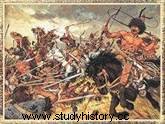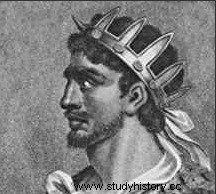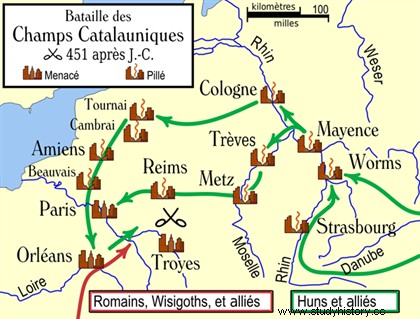 The Battle of the Catalaunian Fields opposed two worlds:that of Attila king of the Huns leading his formidable hordes through Western Europe and that of Gallo-Roman Gaul, former territory of the Roman Empire. This decisive fight did not take place near Châlons-en-Champagne as tradition reports, but near Troyes, at the Mauriacus campus. The Catalan fields are more a founding myth than reality; in all likelihood, the Hunnic army was smaller and much more composite than medieval historiography has long asserted.
The Battle of the Catalaunian Fields opposed two worlds:that of Attila king of the Huns leading his formidable hordes through Western Europe and that of Gallo-Roman Gaul, former territory of the Roman Empire. This decisive fight did not take place near Châlons-en-Champagne as tradition reports, but near Troyes, at the Mauriacus campus. The Catalan fields are more a founding myth than reality; in all likelihood, the Hunnic army was smaller and much more composite than medieval historiography has long asserted.
What happened and in what context?
In the year 451 CE, following the devastation of Eastern Gaul, Attila heads for Orleans. Nothing and no one seems able to stop its fearsome hordes. However, the Hunnic adventure had to stop there, at Cenabum. The Roman Empire is living its last hours and the few Roman legions available are mostly stationed in northern Italy attached to the protection of Ravenna and the Emperor of the moment, Valentinian III.
 In Gaul, only Magister Flavius Aetius, master of the militia at the head of a small cavalry and few cohorts, makes the decision to stem Attila's advance. The disproportion of manpower between his field army and the gigantic army of Attila, forced him to forge alliances with the barbarian kingdoms surrounding the Gallo-Roman territory, of which he was the ultimate representative of the Empire, the " last Roman". An outstanding diplomat, Flavius Aetius will achieve the impossible, the adhesion of most of the barbarian leaders to his ambition to stop Attila in his devastation of Gallo-Roman Gaul.
In Gaul, only Magister Flavius Aetius, master of the militia at the head of a small cavalry and few cohorts, makes the decision to stem Attila's advance. The disproportion of manpower between his field army and the gigantic army of Attila, forced him to forge alliances with the barbarian kingdoms surrounding the Gallo-Roman territory, of which he was the ultimate representative of the Empire, the " last Roman". An outstanding diplomat, Flavius Aetius will achieve the impossible, the adhesion of most of the barbarian leaders to his ambition to stop Attila in his devastation of Gallo-Roman Gaul.
It is the summer of 451, now an armed force will be able to constrain the claims of the Hunnic king. Reinforced by thousands of warriors, Franks, Sarmatians, Alans, Burgundians, Visigoths and others, the generalissimo's army advanced on Orleans, at the very moment when Attila sacked the city, after a resistance of several weeks. Surprised by such a counterattack and following fighting in the streets of the city, Attila was forced to turn back, towards the east. Slowed down by the convoy of its wagons filled with Orleans booty, Attila's army could not outrun the allied army. After a few days and several miles, following each other at some distance, the two armies would have to meet again.
Attila's immense army entered a vast plain of Champagne, with the coalition of Aetius in its rear. This time, the "Gods" had chosen the place of the decisive battle, of the final confrontation. Shortly before the start of the battle, the Gepids, an allied people of Attila, had clashed with the Franks, a federated people allied with Aetius, not far from there, in a place called Campus Mauriacus. A very large number of theirs were exterminated by the Salian warriors during battles of formidable violence. The Gepid survivors of this hell, as well as the Franks joined theirs in the vast plain.
The Great Battle of the Catalaunian Fields
The troops of each army had taken the time to position themselves because none of them wanted to escape the fight, this long-awaited confrontation. The army of the Roman general Aetius occupied a slightly elevated position, as did the hordes of Attila, nearby!
 Troop Dispositions among the Huns; Theodomir, Walamir and Widémir, Ostrogothic kings and princes, command the left wing of the Hunnic army. The Hunnic hordes of Attila occupy the center, as well as the Gepid warriors of King Ardaric, amputated of a large number of their own after the battle of the Mauriacus Campus. As for the right wing, the Vandal warriors of Andagesi form its ranks. Other tribes had joined the Hunnic adventure; the Marcomanni, the Heruli, but also Alamans, Thuringians. As for the Ripuarian Franks, they too had sided with Attila.
Troop Dispositions among the Huns; Theodomir, Walamir and Widémir, Ostrogothic kings and princes, command the left wing of the Hunnic army. The Hunnic hordes of Attila occupy the center, as well as the Gepid warriors of King Ardaric, amputated of a large number of their own after the battle of the Mauriacus Campus. As for the right wing, the Vandal warriors of Andagesi form its ranks. Other tribes had joined the Hunnic adventure; the Marcomanni, the Heruli, but also Alamans, Thuringians. As for the Ripuarian Franks, they too had sided with Attila.
Ally side; The Visigoths of King Theodoric I and his sons, Princes Thorismond and Theodoric II, occupy the right wing. At the center of the coalition, Aetius places the Alans of Sangiban. The Burgundians of King Gondioc, and the Gallo-Romans rubbed shoulders with the Alans. Then come the Sarmatians, heavy horsemen in scale armor, fighting with spears, then the famous field army of the Soissonnais. Lètes elements, and Armorican warriors, complete this armed device. Finally, the end of the left wing benefits from the reassuring presence of the Francs de Mérovée.
Thousands of warriors cover the plain
It was early afternoon when the Huns launched the first attack. The formidable horsemen of the steppe wanted to seize a hill. The shock was terrible for the Romans, and the Visigoths. But, after some time, the Huns were repulsed by Thorismond and Aetius. Then, the fighting became generalized between all the warlike peoples:the Visigoths opposed the Ostrogoths while the heavy cavalry of the Alans fought the Huns. The Romans, meanwhile, fought the other Germanic allies of Attila. The fights were raging, sabers against swords, lassos and spears against swords...
Equipped in Roman style, Aetius' allies succeeded in deceiving the German-Hunnic multitude.
For some time now, the fighting has been going on in the darkness. Galvanized by their king Theodoric, the Visigoths began to push back the Ostrogothic warriors. It was then that, pierced by an enemy spear, Theodoric went to join Valhalla. There followed the unleashing of his people, forcing the Ostrogothic adversary to yield under his pressure. His left flank, therefore stripped of ostrogothic supports, Attila ordered his warriors to erect a circular enclosure with his chariots and his saddles. Then, noting that the fate of the battle was decided, he entrenched himself behind this heap. Ready to set it on fire, to throw himself into the brazier, he then understood that the Visigoths were leaving the battlefield. For Attila, the departure of the main allied people of Aetius is a relief. True, the battle was lost, but his hordes will be able to withdraw from this bloody battlefield.
Aetius, winner of Attila in the Catalaunian fields
Tens of thousands of corpses littered the plain. The Romans were victorious, thanks to the valuable help of the Visigoths. Having paid homage to their deceased king, the Visigoths, under the leadership of Thorismond son of Theodoric, resumed their journey to their kingdom of Aquitaine.
Now, Aetius's main mission remained to watch Attila's retreat towards the Rhine, because his army was still very large and remained a real threat, as long as she will not have crossed the great river. After a few days, this great moment finally arrived, Attila and his formidable hordes recrossed the Rhine. Gaul was finally, definitively freed from the terrible Hunnic threat. Aetius, haloed by his victory, will obtain the prestigious title of Patrice of the Romans, before being assassinated by the Emperor Valentinian III, worried about the popularity of the last of the Romans.
To go further
Year 451, the victory of the West, by Alain Di Rocco. Editions Beaurepaire, 2018.
